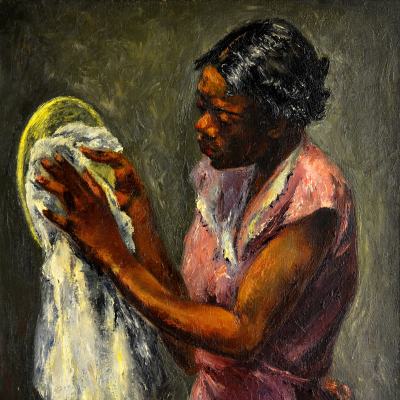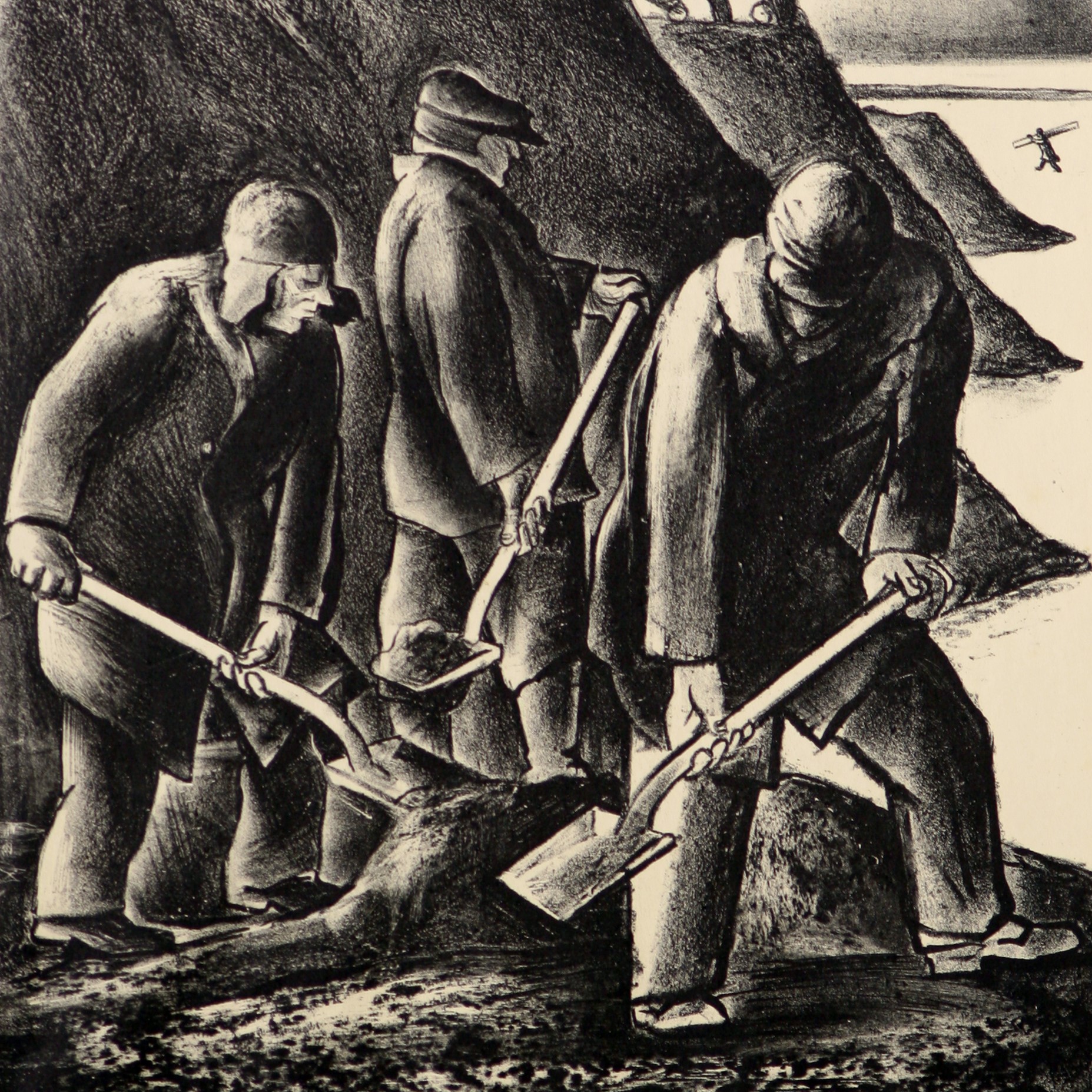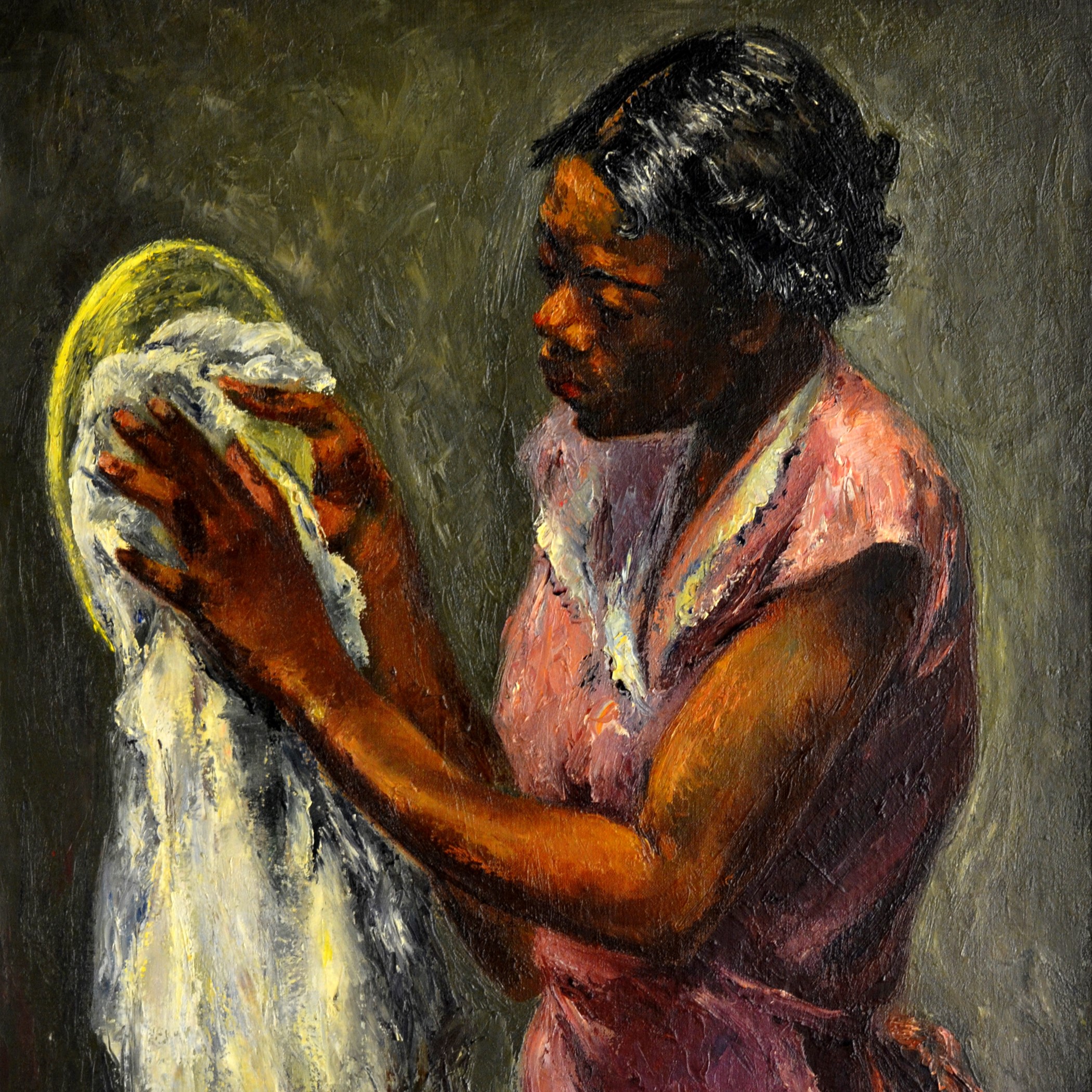The Working Class
Gods, kings, and politicians were figures typically depicted in art throughout history, while lower-class citizens were rarely represented. At the turn of the 20th century in America, artists, starting with the Ashcan School, turned their attention to the working class. The Ashcan School was a group of New York painters who captured the lower class enjoying or toiling through everyday life.
New Deal era government-funded programs such as the Works Progress Administration (WPA) employed millions of Americans in response to the economic hardships brought on by the Great Depression (1929-1933). Its visual arts arm, the Federal Art Project (FAP) (1935-1943), provided work relief for artists in various media--painters, sculptors, muralists, and graphic artists. In addition, the Farm Security Administration (FSA) hired photographers to capture rural, impoverished America to demonstrate farmers’ hardships. Some artists employed during this time showed the Great Depression and the Dust Bowl’s gruesome impact on Americans. Others opted to portray rural workers in a romanticized, more positive light, highlighting the strength and resilience of American laborers, farmers, factory employees, and railroad workers.
Art is often used as a powerful tool to highlight the imbalance of wealth in the world. For example, Nicola Ziroli’s painting and Martin Lewis’ etching focus on women in the 1930s, who are undoubtedly from different socioeconomic classes. Lewis depicts a lavishly dressed woman enjoying the streets of New York, seemingly unaffected by the economic crash. Alternatively, Ziroli and Russel Limbach’s works showcase people working long, straining hours for dimes a day.
Text by Amanda Pope
Russell Limbach (b. 1904 - d. 1971)
CWA Workers, 1935
lithograph
Donation of WPA Federal Art Project
CWA stands for “Civil Works Administration,” a short-term job creation agency that provided construction work for unemployed Americans during the Great Depression. Limbach depicts three sturdy men standing in the foreground, shoveling dirt along the water. In the background, smaller men in profile appear to be depositing the dirt atop two hills, perhaps building a levee. The details of their faces are not visible, putting more focus on the labor of their bodies. As we can see here, they are hunching over, emphasizing their strength while working together to improve America’s infrastructure.
Russell Limbach was a printmaker from Ohio. He worked under the Federal Arts Program (FAP), a program that provided income to artists working in various media. Russell was the head of the Graphics Division of the FAP in New York.
Text by Cecilia Nuño-Maciel
Nicola Ziroli (Italian, b. 1908 - d. 1970)
30 Cents an Hour, 1939
oil on canvas
Donation of WPA Federal Art Project
30 Cents an Hour depicts an African American woman washing and drying dishes for a meager wage during the Great Depression. The painting was made in 1939 by an Italian artist Nicola Ziroli through the Works Progress Administration. The artist’s choice of realism, including the details of the fingers holding the cloth and the look of concentration on the woman’s face, allows the viewer to connect with her on an emotional level. In addition, the shallow picture plane and the angle at which Ziroli depicts the figure make one feel as if they are sitting right next to her. This work provides a glimpse into the realities faced by African American women during the 1930s.
Text by Jackson Nicodemus
The Working Class
Gods, kings, and politicians were figures typically depicted in art throughout history, while lower-class citizens were rarely represented. At the turn of the 20th century in America, artists, starting with the Ashcan School, turned their attention to the working class. The Ashcan School was a group of New York painters who captured the lower class enjoying or toiling through everyday life.
New Deal era government-funded programs such as the Works Progress Administration (WPA) employed millions of Americans in response to the economic hardships brought on by the Great Depression (1929-1933). Its visual arts arm, the Federal Art Project (FAP) (1935-1943), provided work relief for artists in various media--painters, sculptors, muralists, and graphic artists. In addition, the Farm Security Administration (FSA) hired photographers to capture rural, impoverished America to demonstrate farmers’ hardships. Some artists employed during this time showed the Great Depression and the Dust Bowl’s gruesome impact on Americans. Others opted to portray rural workers in a romanticized, more positive light, highlighting the strength and resilience of American laborers, farmers, factory employees, and railroad workers.
Art is often used as a powerful tool to highlight the imbalance of wealth in the world. For example, Nicola Ziroli’s painting and Martin Lewis’ etching focus on women in the 1930s, who are undoubtedly from different socioeconomic classes. Lewis depicts a lavishly dressed woman enjoying the streets of New York, seemingly unaffected by the economic crash. Alternatively, Ziroli and Russel Limbach’s works showcase people working long, straining hours for dimes a day.
Text by Amanda Pope
Russell Limbach (b. 1904 - d. 1971)
CWA Workers, 1935
lithograph
Donation of WPA Federal Art Project
CWA stands for “Civil Works Administration,” a short-term job creation agency that provided construction work for unemployed Americans during the Great Depression. Limbach depicts three sturdy men standing in the foreground, shoveling dirt along the water. In the background, smaller men in profile appear to be depositing the dirt atop two hills, perhaps building a levee. The details of their faces are not visible, putting more focus on the labor of their bodies. As we can see here, they are hunching over, emphasizing their strength while working together to improve America’s infrastructure.
Russell Limbach was a printmaker from Ohio. He worked under the Federal Arts Program (FAP), a program that provided income to artists working in various media. Russell was the head of the Graphics Division of the FAP in New York.
Text by Cecilia Nuño-Maciel
Nicola Ziroli (Italian, b. 1908 - d. 1970)
30 Cents an Hour, 1939
oil on canvas
Donation of WPA Federal Art Project
30 Cents an Hour depicts an African American woman washing and drying dishes for a meager wage during the Great Depression. The painting was made in 1939 by an Italian artist Nicola Ziroli through the Works Progress Administration. The artist’s choice of realism, including the details of the fingers holding the cloth and the look of concentration on the woman’s face, allows the viewer to connect with her on an emotional level. In addition, the shallow picture plane and the angle at which Ziroli depicts the figure make one feel as if they are sitting right next to her. This work provides a glimpse into the realities faced by African American women during the 1930s.
Text by Jackson Nicodemus
The Working Class
Gods, kings, and politicians were figures typically depicted in art throughout history, while lower-class citizens were rarely represented. At the turn of the 20th century in America, artists, starting with the Ashcan School, turned their attention to the working class. The Ashcan School was a group of New York painters who captured the lower class enjoying or toiling through everyday life.
New Deal era government-funded programs such as the Works Progress Administration (WPA) employed millions of Americans in response to the economic hardships brought on by the Great Depression (1929-1933). Its visual arts arm, the Federal Art Project (FAP) (1935-1943), provided work relief for artists in various media--painters, sculptors, muralists, and graphic artists. In addition, the Farm Security Administration (FSA) hired photographers to capture rural, impoverished America to demonstrate farmers’ hardships. Some artists employed during this time showed the Great Depression and the Dust Bowl’s gruesome impact on Americans. Others opted to portray rural workers in a romanticized, more positive light, highlighting the strength and resilience of American laborers, farmers, factory employees, and railroad workers.
Art is often used as a powerful tool to highlight the imbalance of wealth in the world. For example, Nicola Ziroli’s painting and Martin Lewis’ etching focus on women in the 1930s, who are undoubtedly from different socioeconomic classes. Lewis depicts a lavishly dressed woman enjoying the streets of New York, seemingly unaffected by the economic crash. Alternatively, Ziroli and Russel Limbach’s works showcase people working long, straining hours for dimes a day.
Text by Amanda Pope
Russell Limbach (b. 1904 - d. 1971)
CWA Workers, 1935
lithograph
Donation of WPA Federal Art Project
CWA stands for “Civil Works Administration,” a short-term job creation agency that provided construction work for unemployed Americans during the Great Depression. Limbach depicts three sturdy men standing in the foreground, shoveling dirt along the water. In the background, smaller men in profile appear to be depositing the dirt atop two hills, perhaps building a levee. The details of their faces are not visible, putting more focus on the labor of their bodies. As we can see here, they are hunching over, emphasizing their strength while working together to improve America’s infrastructure.
Russell Limbach was a printmaker from Ohio. He worked under the Federal Arts Program (FAP), a program that provided income to artists working in various media. Russell was the head of the Graphics Division of the FAP in New York.
Text by Cecilia Nuño-Maciel
Nicola Ziroli (Italian, b. 1908 - d. 1970)
30 Cents an Hour, 1939
oil on canvas
Donation of WPA Federal Art Project
30 Cents an Hour depicts an African American woman washing and drying dishes for a meager wage during the Great Depression. The painting was made in 1939 by an Italian artist Nicola Ziroli through the Works Progress Administration. The artist’s choice of realism, including the details of the fingers holding the cloth and the look of concentration on the woman’s face, allows the viewer to connect with her on an emotional level. In addition, the shallow picture plane and the angle at which Ziroli depicts the figure make one feel as if they are sitting right next to her. This work provides a glimpse into the realities faced by African American women during the 1930s.
Text by Jackson Nicodemus



